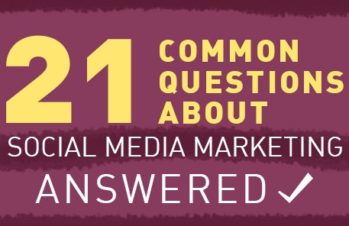Today, we are excited to bring you a guest post written by John Jantsch. This post was drawn from the teachings contained in his latest book, Duct Tape Selling – Think Like a Marketer Sell Like a Superstar.
Connecting the dots in an organization’s community requires a deep understanding of how the community actually forms in most businesses. It’s not about Facebook pages and catchy slogans. It’s much more subtle and requires that you start thinking about organizational elements that you’ve probably never considered before. I believe a business forms community through the following six elements.
Clarity
To understand a company’s purpose and to see how they communicate that to the community—go straight to the community. Locate some customers and employees of the prospect and put them into a simple CRM to track their public social media activity. It’s amazing what you can learn about a company by watching how they interact in places like Facebook and Twitter.
Often you’ll find proof of what they stand for, what values they promote, and how they interact. How they act online can tell you a great deal about who they are as an organization. You might find that their public words and actions don’t completely align with their marketing messages.
Even better, try to find a way to ask questions of the company’s staff or customers. You’re looking for clues about what the market really thinks of their brand. This is also a good way to uncover opportunities and unmet needs.
Culture
If you have any luck uncovering employees from the company, you might just want to look for clues that will tell you how they feel about working for the company. Twitter is actually a really good place to learn about company culture. You can see the way a company interacts with its community for ideas and get a read from actual customers about how they are being treated. You’ll probably get some responses and this can be a fantastic way to understand a company more deeply than their website marketing speak could ever show.
Also, research the company’s written material, such as mission statements, core values, etc. Do these seem to fit in with some sort of higher purpose for the company? Does it align with their reason for existing? Can you think of a single word that the market might use to describe their brand?
Method
Communities don’t generally form around products, services or companies. Instead, they form around ideas, methodologies, and processes that make it possible for them to have something in common with others. The method is the way to get the energy required to gain momentum in the market and in a community.
This suggests that creating and communicating different methods and points of view that help buyers figure out how to think about their problems in new ways is incredibly important. When you do this and you give a name and a set of steps to your way of thinking, you create the potential for a shared language around an idea. You’ve now created fuel for a cause—and have given your staff and customers a way to communicate in a common way.
You can often find a company’s methods with a little digging for things like white papers, eBooks, and brochures. Do they seem to all be about the unique point of view or way of doing business? Do they use their own terminology, processes, and checklists? By monitoring a prospect’s different forms of communication and mining social networks, you may find they have created a community of customers that are able to speak to each other using a common language.
Content
Content is the story a company produces that tells its purpose, culture, trust, and method to the world. It gives the community a growing voice, for good or bad, and how a company builds knowledge that ultimately communicates a much bigger story.
In many ways, this is where the internal and external worlds of the community come together. The various forms of content an organization publishes should help them tell the story of why they do what they do. This will also communicate in a way that educates, informs, builds trust, and ultimately moves a prospect toward becoming a customer.
Additionally, content is one of the best ways to engage community members. Do customers participate in creating content? Do they receive feedback and comments from readers and users? Do employees at every level participate in the creation of content?
Start building a library of every bit of content the prospect or client publishes. You can learn a lot about what the company values and where gaps exist by understanding their content approach.
Are they using content to build awareness, trust, and engagement or only when they try to sell? Become a customer of the companies you’re researching and see how they use content in the sales and follow-up process. What do their responses to inquiries look and sound like? Do they intentionally make their content shareable?
Presence
There are many ways to access a business and its offerings. Social media has largely increased that access and maybe even diluted it by giving people so many options for engagement.
Both online and off, a company’s story must unfold in a total presence. They need to open access points in social networks, email, advertising, and PR. They must create a culture of listening and responding. They have to facilitate and collaborate at every turn. People are now discovering and joining communities in ways that marketers never considered.
Collect as much advertising, public relations, social network and referral activity on your prospects and clients as possible. Subscribe to email newsletters and engage in social media contests. Are they sending clear and integrated messages? Are there messages that don’t seem to go together? Does their marketing presence match the clarity and culture research you’ve done?
Touchpoints
The Marketing Hourglass framework helps engage and attract people to a community, but you still need to give them ways to engage at the highest possible level. Not only does this turn a community into a direct stream of revenue, but it also allows members to sort, sift, and determine their roles. A community member that doesn’t purchase will often influence others. By creating levels of engagement, you allow your members to define the role that makes sense in their world and create a complete system necessary to nurture the whole community.
Create a map of all the ways you an organization engages prospects and customers using the Hourglass concept. The easiest way to create a touchpoint map is to make a grid listing the steps (know, like, trust, try, but, repeat and refer) down one side and then try to add all of the ways your prospect comes into contact with its customers and prospects. Try to map out their sales and customer service processes.
These six organizational elements are the key to forming a community in a business. When you understand how a business forms its community, you can better understand their goals, wants, and needs. By becoming a part of their community, you can get an inside view into how the business interacts with its customers and prospects.
John Jantsch is a marketing consultant, speaker and author of Duct Tape Marketing, The Commitment Engine and The Referral Engine and the founder of the Duct Tape Marketing Consultant Network. His latest book, Duct Tape Selling – Think Like a Marketer, Sell Like a Superstar is available online and in bookstores May 15.







